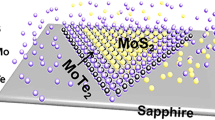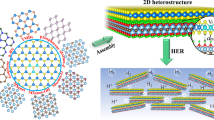Abstract
Oxidation of two-dimensional (2D) transition metal dichalcogenides have received great interests because it significantly influences their electrical, optical, and catalytic properties. Monoclinic MoO2 nanowires grow along the zigzag direction of 2D MoS2 via thermal annealing at a high temperature with a low oxygen partial pressure. The hybrids of semiconducting 2D MoS2 and metallic 1D MoO2 nanowires have potential to be applied to various devices such as electrical devices, gas sensors, photodetectors, and catalysts.
Similar content being viewed by others
Description
Two-dimensional (2D) transition metal dichalcogenides (TMDs) have received great interests because of their outstanding electrical, optical, and catalytic properties. However, these properties are significantly influenced by oxidation. Moreover, heterostructure of transition metal oxides (TMOs) and TMDs are emerging as promising candidates for functional devices such as gas sensor, photodetector, and catalyst. Therefore, synthesizing multidimensional TMDs and TMOs hybrids are actively studied. (Molina-Mendoza et al., 2016).
Herein, we propose a new synthetic route for growth of 1D MoO2 nanowires and 2D MoS2 flakes hybrids via thermal oxidation of MoS2. Oxidation into MoO3 is common phenomenon in ambient conditions, but metallic MoO2 nanowires grow at a high temperature with a low oxygen partial pressure. The hybrids are investigated using transmission electron microscopy (TEM) and scanning electron microscopy (SEM). TEM imaging was performed with a FEI Titan Cube G2 60–300 instrument operated at 200 kV with an image aberration corrector, and SEM imaging was performed with Hitachi High-Technologies S-4800.
In Fig. 1a, SEM image clearly shows that 1D nanowires are grown along the edges of 2D MoS2 flake, and the energy dispersive spectroscopy results in Fig. 1c confirm that they are molybdenum oxides. Moreover, Fig. 1d-e atomic-scale scanning TEM (STEM) images show that the molybdenum oxides are monoclinic MoO2 with distorted rutile structure. The growth direction of nanowires is [100] which is same as the results in previous papers. (Vogl et al., 2019) In addition, MoO2 nanowires are dominantly grown in six radial orientations at MoS2 as indicated by the arrows in Fig. 1a. These orientations are consistent with the zigzag directions of MoS2.
High contact resistance of TMDs is one of the key bottlenecks for applying TMDs to electrical devices. However, synthesizing the hybrids of semiconducting 2D MoS2 and metallic 1D MoO2 nanowires can be a solution. Metallic MoO2 nanowires can be adopted as an electrode of MoS2 directly, and hybridization between MoO2 and MoS2 might remove the Schottky barrier height and decrease the contact resistance. This simple synthetic route can be applied to many other 2D materials, and these 1D oxides-2D material hybrids can be used for not only electronic devices, but also catalytic, and optical devices.
Availability of data and materials
Not applicable.
References
A.J. Molina-Mendoza, J.L. Lado, J.O. Island, M.A. Niño, L. Aballe, M. Foerster, F.Y. Bruno, Centimeter-scale synthesis of ultrathin layered MoO3 by van der Waals epitaxy. Chem. Mater. 28(11), 4042–4051 (2016)
L.M. Vogl, P. Schweizer, M. Wu, E. Spiecker, Transform layered MoS2 into functional MoO2 nanowires. Nanoscale. 11, 11687–11695 (2019)
Acknowledgements
Not applicable.
Funding
This work was supported by IBS-R019-D1.
Author information
Authors and Affiliations
Contributions
ZL supervised the project. ARY prepared the sample and took images and wrote the manuscript. All authors read and approved the final manuscript.
Corresponding author
Ethics declarations
Competing interests
The authors declare that they have no competing interests.
Additional information
Publisher’s Note
Springer Nature remains neutral with regard to jurisdictional claims in published maps and institutional affiliations.
Rights and permissions
Open Access This article is distributed under the terms of the Creative Commons Attribution 4.0 International License (http://creativecommons.org/licenses/by/4.0/), which permits unrestricted use, distribution, and reproduction in any medium, provided you give appropriate credit to the original author(s) and the source, provide a link to the Creative Commons license, and indicate if changes were made.
About this article
Cite this article
Yoon, A., Lee, Z. Formation of two-dimensional MoS2 and one-dimensional MoO2 nanowire hybrids. Appl. Microsc. 49, 16 (2019). https://doi.org/10.1186/s42649-019-0020-6
Received:
Accepted:
Published:
DOI: https://doi.org/10.1186/s42649-019-0020-6





